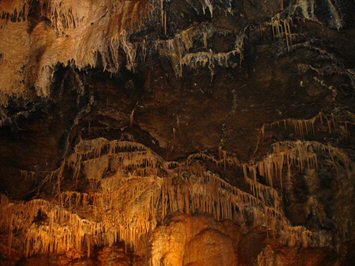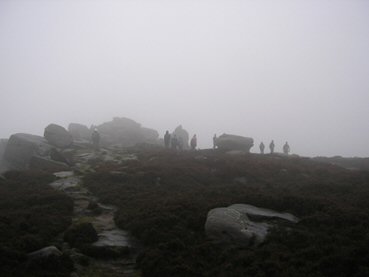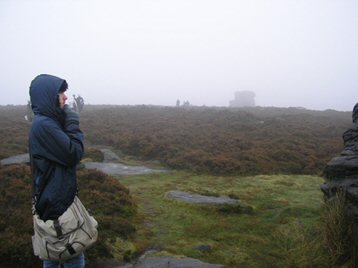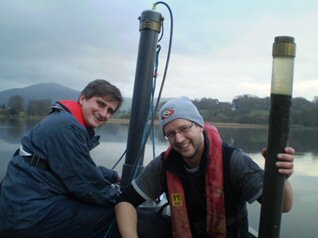
November 14, 2011, by lgzsm
Matt Jones and Suzanne McGowan talk us through what they got up to in this semester’s Fieldwork Week
On Monday and Tuesday we led field trips for our first year Physical Landscapes of Britain module up to what was a misty and eerie Peak District.
We run the same trip twice, but it’s a good trip out comparing the differences in landscape between the Dark Peak and the White Peak; dominated by Carboniferous Millstone Grit and Limestones respectively.
The trip includes a tour of Treak Cliff Cavern, to look inside the limestone and hear about the mining of Blue John; the Castleton areas of the Peak District has been an industrial area for many years thanks to its geological location.

Cave!
On Tuesday night we drove up to the Lake District with our PhD student Heather Moorhouse and our visiting colleague Jasmine Saros from the University of Maine. The plan was to take sediment cores from lakes that drain into Lake Windermere in order to reconstruct changes in lake ecology over the past 2-300 years. The lakes within the Windermere catchment vary from small upland tarns to larger lakes in the lowlands, and across this landscape there is a varying degree of influence from sewage and agricultural pollutants. By investigating change across the entire catchment we hope to get a better idea of how water quality in Windermere has changed through time and what restoration targets for the lake should be. This is part of a larger initiative the ‘Windermere Catchment Restoration Project’ comprising a range of stakeholders, who recently opened an office in Ambleside to publicise this ongoing work.
Wednesday was spent at the Freshwater Biological Association on the shores of Windermere, talking to Liz Howarth, a legendary palaeolimnologist, about all her previous work in the area and finalising the permissions we needed from Natural England, The National Trust and landowners to carry out the work. We also stocked up on vital supplies of Grasmere gingerbread and local ales. On Thursday we took cores from Esthwaite and Blelham Tarn with our collaborators on this project from Lancaster University; Phil Barker (who also happens to be our external examiner in Nottingham) and his new PhD student Susan Brayshaw. It was a successful day with 5 cores taken.
On Friday we went for a hike – and took four cores on the way. It was a long day walking up to Stickle Tarn from Langdale, with boat, corer and all! Those people who had started their weekends early with a Friday hike were slightly surprised to find some crazy scientists floating around on Stickle Tarn when they finished their climb up from the car park!
We then walked over a ridge to Easedale Tarn to get two cores from that site; finishing just in time to get back to our other car that we’d parked in Easedale earlier that morning before it got too dark. A long, tiring, but successful and fantastic day!
On Saturday Suzanne and her boyfriend Nick, who had replaced Heather for the day, headed out and cored our last lake, Loughrigg Tarn, whilst Matt and Jasmine stayed back at base extracting the cores we’d taken on Thursday. Each core we took has to be sliced into 5mm slices so we can get a detailed picture about how the lakes have changed through time.
It truly was a week of fieldwork – with lashings of ginger and beer!
From Hawkshead Hill,
Matt and Suzanne.
No comments yet, fill out a comment to be the first





Leave a Reply